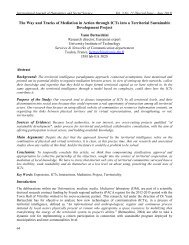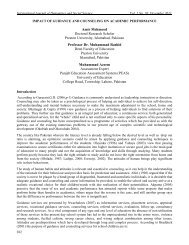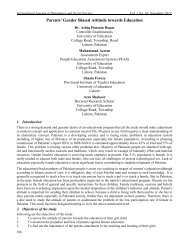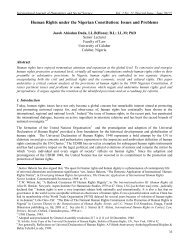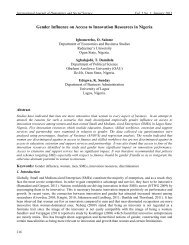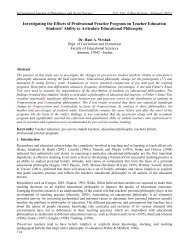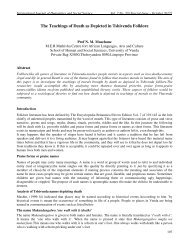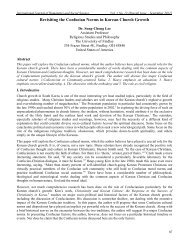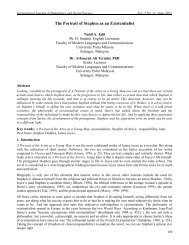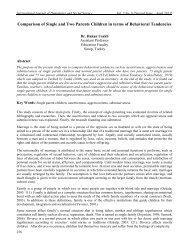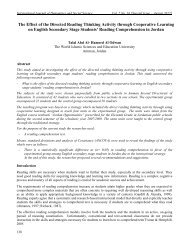THE ROLE OF TRADITIONAL SKILLS AND TECHNIQUES IN THE ...
THE ROLE OF TRADITIONAL SKILLS AND TECHNIQUES IN THE ...
THE ROLE OF TRADITIONAL SKILLS AND TECHNIQUES IN THE ...
Create successful ePaper yourself
Turn your PDF publications into a flip-book with our unique Google optimized e-Paper software.
International Journal of Humanities and Social Science Vol. 1 No. 13 [Special Issue – September 2011]<br />
<strong>THE</strong> <strong>ROLE</strong> <strong>OF</strong> <strong>TRADITIONAL</strong> <strong>SKILLS</strong> <strong>AND</strong> <strong>TECHNIQUES</strong> <strong>IN</strong> <strong>THE</strong> DEVELOPMENT <strong>OF</strong><br />
MODERN SCIENCE <strong>AND</strong> TECHNOLOGY <strong>IN</strong> AFRICA<br />
AKPOMUVIE, ORHIOGHENE, BENEDICT Ph.D<br />
DELTA STATE UNIVERSITY<br />
SOCIOLOGY DEPARTMENT<br />
P.M.B. 1<br />
ABRAKA, DELTA STATE, NIGERIA<br />
Abstract<br />
The main thrust of this paper, is that Africa needs to work out technological system that is economically efficient<br />
as well as appropriate to her environment. Besides identifying the nature of technology, the paper argued that<br />
prior to the advent of the Europeans and Arabs, remarkable technological innovations were made by pre-colonial<br />
Africans in traditional iron, wood and ivory working as well as in cloth weaving, pottery and indigenous drugs<br />
development. It further argued that successive governments in Africa, especially Nigeria, have continued to<br />
encourage (though inadvertently) the decline of indigenous technology through the uninhibited importation of all<br />
forms of foreign technology without local inputs. This has generated over time, a culture of wholesomely<br />
imported technology which is intrinsically unviable within the culture and environment of the African society.<br />
The paper however, recommended that researchers and other technical experts must find time to develop<br />
research proposals that seek to up-grade our indigenous skills. More importantly Africans should rededicate<br />
themselves to pursue vigorously and realistically, the processes of cultural synthesis and hybridization of the host<br />
culture and the guest culture in the sphere of science and technology.<br />
Key works: Indigenous knowledge, collaboration, resources, upgrade, institutionalize, reciprocity, grassroots,<br />
innovation, appropriate, etc.<br />
Introduction<br />
Any culture, developed by any ethnic taxon or race, employs and manipulates two aspects of knowledge:<br />
particularistic and universalistic. Particularistic knowledge is that aspect which marks out one culture from the<br />
other and therefore one ethnic taxon from others. According to Onwuejeogwu (1999) it is a body of intellectual<br />
wealth, constituting a people‟s basic non-material culture which changes at a very slow rate even during and after<br />
a revolution. The other aspect of knowledge called universalistic knowledge, is materialistic in nature and is best<br />
typified by technology of which the first and most crude forms originated in the continent of Africa and spread<br />
into other parts of the world where it went through complications and elaborations (Leakey: 1936, 1951,<br />
Onwuejeogwu, 1975).<br />
Before the colonial experience in Africa, indigenous technology was well expressed in the local systems.<br />
Remarkable technological innovations were made by pre-colonial Africans in traditional iron, wood and ivory<br />
working as well as in cloth weaving, pottery and indigenous drugs development. Most of the techniques involved<br />
in these processes were however, either disoriented or discontinued but were well suited to the environment and<br />
culture of the people (Okpoko and Ezeadichie, 1999). Traditional technology laid emphasis on the quality of life<br />
as measured in human, cultural and spiritual terms rather than in purely materials terms. Its primary goal was to<br />
equip everyone with the basic knowledge of how all essential tasks of life are carried out. In this manner (Andah,<br />
1992), argued that everybody was instilled with a felling of self-respect borne out of confidence in their own<br />
ability to help themselves. But this confidence he further argued, has been eroded by the invasion of European<br />
forms of modernization. This is not because these forms are necessarily bad but because the way and manner they<br />
were introduced was subversive.<br />
Before Africans came in contact with Europe in the fifteenth century, our technological systems may have been<br />
underdeveloped and ready to take off but were not developed. The present underdevelopment of Africa thus<br />
resulted primarily from the primitive exploitation of the continent and resources for the benefit of the Arab and<br />
European world. This was unleashed with the slave trade, Arab and European “legitimate” trade, colonization<br />
and neocolonialism. European colonization and imperialism helped to initiate the decay of our technological and<br />
cultural institutions. This is in the sense that the institutional and cultural forms which existed prior to colonial<br />
rule and conquest became either inoperative or went on the decline (Andah, 1992).<br />
178
The Special Issue on Social Science Research © Centre for Promoting Ideas, USA www.ijhssnet.com<br />
Similarly, successive governments in Africa on attainment of independence, have continued to encourage (though<br />
inadvertently) the decline of indigenous technology through the uninhibited importations of all forms of foreign<br />
technology. There has been the tendency towards the establishment of wholesomely imported technology which<br />
is intrinsically unviable within the culture and environment of the African society. On the part of Africans, the<br />
general feeling of inferiority (generated by this massive importation syndrome) has given rise to negative ideas<br />
about products of indigenous technology while foreign products are seen as superior. As rightly argued by<br />
Okpoko (1999) all these have had adverse effects on what indigenous technology can contribute to sustainable<br />
development in Africa. The main thrust of this article is that we need to work out a technological system that is<br />
economically efficient as well as appropriate to our resources. Such a system would require an African scientific<br />
system which is directly applicable to our changing societies. To do this appropriately, we have to digest the facts<br />
of our histories properly and then use these facts to proffer suggestions for the molding of our collective future.<br />
As Andah (1992) succinctly argued, the mere transfer of supposedly sophisticated international technology,<br />
designed for altogether dissimilar circumstances, has so far resulted in a dualistic situation whereby growth is<br />
concentrated in a relatively small modern sector but does not percolate through to the rest of the economy to any<br />
significant extent. This has had the harmful effects of displacing previously existing and still very relevant forms<br />
of technology without serving as an adequate cultural substitute he contended. An appropriate technology for<br />
Africa in my view is one which takes into account our society‟s particular stage of economic growth, social<br />
development, development goals and resource endowments. Since the colonial era, many African countries<br />
particularly Nigeria, have been saddled with inappropriate systems of technology arising from the fact that the<br />
relative scare factors of production like foreign exchange, were intensively dissipated. On the other hand, several<br />
factors such as local raw materials and local skills were ignored and left to idle away. The result according to<br />
Andah has been a perpetuation of technological dependence.<br />
Conceptual Framework<br />
The fact to be borne in mind always is that the advancement made in the field of technology cannot be attributed<br />
to any one race. It is the cumulative achievement of mankind as a whole. Universalistic knowledge did not start<br />
in 1750 with the advent of Industrial Revolution. For Onwuejeogwu (1999), western man should stop pretending<br />
as if it did. The two words „Industrial Revolution‟, to modern man seem to have mystifying connotations.<br />
Indeed, there have been several other important revolutions in human history. A gigantic stride in primitive<br />
technology occurred when man made his first pebble tools in Eastern Africa. This is what Onwuejeogwu calls the<br />
„Great Lithic Revolution‟.<br />
The application of scientific knowledge and skill for the improvement of both the physical and rational aspects of<br />
life is the basic essence of technology. Wie (1992) describes technology as the knowledge and machinery needed<br />
to run enterprises including the software (skill) and hardware (equipment). Technology in a very broad sense,<br />
involves entrepreneurial expertise and professional know-how to carry out planned programmes (Sanitikarn,<br />
1982). Similarly, Gabriel (1999), Olaoye (1999) and Wachuku (1991) see technology as the system of tools,<br />
artifacts and techniques employed by a particular people to modify conditions and resources in the environment to<br />
meet their basic material needs. Gamser et al (1990) however, contended that technology is more than just<br />
equipment. It is a combination of knowledge, skills and equipment to provide goods and services to the<br />
population. Fadahunsi (1986) sees technology, as a scientific knowledge aimed at satisfying the basic needs and<br />
objectives of man and is classified into three broad categories: the human embodied technology such as skills,<br />
knowledge and experience; the capital – embodied technology such as machines, equipment, tools and the<br />
disembodied technology which includes blue – prints, products and product specifications.<br />
Andah (1992) sees technology rather from the context of cultural history, tradition, progress, cultural values and<br />
civilization. Considered from a cultural perspectives, technology refers to all that it takes (in terms of mental and<br />
material energy) for man to set in motion the natural forces of his arms, legs, head and entire body – in order to<br />
make natural materials available in form useful to his own life. It represents all man‟s effort to influence and<br />
control nature to aid his survival as a social being as well as all his attempts to solve essential but specific material<br />
and spiritual problems of his life. These include; problems of obtaining food, shelter, clothing, procreation and its<br />
physical as well as spiritual upliftment and satisfaction. He further added that technology may also be simply<br />
regarded as the material expression of a people‟s life, values and attitudes that is culture. In his robust<br />
understanding of the concept,<br />
179
International Journal of Humanities and Social Science Vol. 1 No. 13 [Special Issue – September 2011]<br />
Andah distinguished between science and technology thus: while science involves the understanding of<br />
theoretically postulated entities and their interrelationships, technology is concerned with a people‟s<br />
understanding of specific objects and their functions in relation to the people. He further postulated that changes,<br />
developments and innovations in technology depend on changes in man‟s notion of what is desirable and on<br />
changes in his store of scientific knowledge which affect his understanding of casual links and the extent to which<br />
these can be manipulated or controlled by man. In contrast to this, science‟s most characteristic output is<br />
knowledge, aimed at enhancing man‟s understanding of some aspects of the natural world. Thus, to Andah,<br />
technology and science are distinguishable forms of human activity which, at times, in the course of their<br />
historical development, have been virtually isolated from each other and at other times, closely intertwined.<br />
Technological content is regarded by Hannay and Mc Ginn (1980) as the complex knowledge, methods and other<br />
resources used in making a particular kind of product or in creating a particular procedural system at a given time<br />
in a particular society. Thus, the content of technology at a given time in a particular society consists of the<br />
ensemble of all the technologies used to produce all the techniques in use at that society. Technology taken in this<br />
broad sense includes a wide variety of ways of doing things: producing foodstuffs, settling disputes,<br />
communicating, making work etc. These scholars however concluded that all societies develop their specific<br />
procedures to this end in all societies and technology has always been subject to change.<br />
Similarly, Ackermann (1981) averred that although technological innovation is in itself a form of change, it brings<br />
with it, other changes in social, economic and political life. Technology thus comprises the public knowledge of<br />
artifacts and their use in society. But even though technology may be identified with knowledge rather than<br />
artifacts, it is neither the same as science which is conceptual knowledge involving mental models applicable in a<br />
large number of concrete situations. Technological knowledge can be highly scientific and abstract but it can also<br />
be highly concrete and empirical. The process of creating technology for the first time is quite different from the<br />
process of specifying it in order that it can be reproduced by others. The creation process is culture dependent but<br />
its reproducibility makes it technology rather than art (Brooks, 1980).<br />
In a similar vein, Andah (1990) clearly stated that although technology may be defined in other narrow ways –<br />
since every natural and social phenomenon possesses infinite facets, for our purposes, it suffices to note that one<br />
distinguishing feature of technology is that it concerns all practical things. Historically according to him, there is<br />
reciprocity between technological change and developments in practical fields like hunting and collecting,<br />
farming and stock keeping, in all forms of industries and domestic and non-domestic crafts; in building and<br />
transport as well as in warfare. To sum up his position, technology to us then is a man‟s way of applying<br />
culturally determined and directed scientific knowledge to practical use, so that he can live more comfortably and<br />
more securely, although not necessarily more peacefully than before.<br />
Like other aspects of a people‟s cultural traditions, technological traditions are continually changing, even though<br />
they may outwardly appear static or fixed. The nature, direction and the rate of change are not necessarily the<br />
same neither for different societies, nor even for the same society at different time periods. Rather, they differ,<br />
depending on a complex manner, on factors such as time, geography, available natural resources and the<br />
particular people‟s modes of thoughts as embodied in their history. If tradition refers to that which has the force<br />
of law, that which is honoured by everyone through collective assent, that which is obeyed by all those sharing the<br />
values, progress in its simplest sense, connotes the act of moving forward. But as with all kinds of cultural<br />
progress, there is no yardstick for measuring this forward movement of technological progress. That is not to say<br />
that the innovation process cannot be characterized in a general sense (Andah, 1999). Brooks (1980) defined it as<br />
the process by which technology is conceived, developed, codified and deployed on a large scale. Its reproducible<br />
and transferable nature makes it possible for technology to be diffused widely with speed. Innovation is the major<br />
source of economic growth in any society: it is almost certainly more vital than physical factors, such as labour<br />
and capital.<br />
Indigenous Technology<br />
On a broad scale, however, Bhagavam (1979) stressed that technology can be classified as indigenous –<br />
(endogenous) and foreign (exogenous). While the former refers to the internally generated methods of learning<br />
and expressing grassroots initiatives in technology, the latter deals with the transferred (imported) or foreign<br />
input in the technology of a society or nation. In addition, Bhagavam stated that indigenous technology is also<br />
referred to as traditional technology.<br />
180
The Special Issue on Social Science Research © Centre for Promoting Ideas, USA www.ijhssnet.com<br />
According to Usman (1991), indigenous is used to describe a thing that originates or occur naturally in a country,<br />
region, etc. For anything to be indigenous, it must belong to the people in question rather than being alien to<br />
them. He further stated that technology describes the application of practical or mechanical sciences to industry<br />
and commerce. It is the total knowledge and skills available to any human society for industry, art, science, etc.<br />
Therefore, indigenous technology can be said to mean the application of practical or mechanical sciences based<br />
on the available local resources and skills to industry and commerce. Similarly, RRDA/WRES conceptualize<br />
indigenous technology as technologies employed by the native inhabitants of a country and which constitute<br />
important part of its cultural heritage and should therefore be protected against exploitation by industrialized<br />
countries. The problem of indigenous knowledge has been discussed during the RIO Conference but it does not<br />
receive much protection under the Biodiversity Convention. Article 8 mandates that parties “respect, preserve<br />
and maintain knowledge, innovations and practices of indigenous and local communities embodying traditional<br />
life styles… and promote their wider application with the approval and involvement of holders of such<br />
knowledge; innovations and practices and encourage the equitable sharing of benefits arising from them.”<br />
The Need to Emphasize Traditional Skills and Techniques<br />
It is wrongly assumed that African people are backward because the means of production known among the<br />
Europeans were not present in Africa or because our ancestors used different methods to build their houses, to<br />
farm, to dress and to cure themselves of physical or spiritual distress. To many scholars according to Okon<br />
(1991), any movement to adopt and strengthen traditional technologies is backward and primitive. Such people<br />
Okon added, argue that the most pressing technical problems connected with man‟s earthly welfare have been<br />
solved through the use of techniques which are either very advanced or are related to traditional skills. The view is<br />
based on five false assumptions: first, that research results, in any part of the world are international property; as<br />
such any country can demand and obtain access to them. Secondly, that all existing inventions can be readily<br />
transferred from their country of origin. Thirdly, that all our technology needs are such that could be fully<br />
satisfied from sources remote to us. Fourthly, that the economy of any nation can support the importation of<br />
technologies required to satisfy all her needs. And fifthly, that indigenous technology is too rudimentary to be<br />
used even as a springboard for the development of the more advanced systems and processes required for the<br />
solution of many contemporary technological problems.<br />
It is obvious from experience and practice of the advanced laboratories of the world, that certain research results<br />
are never made available outside a restricted group which is determined by the sponsors of the research. Such<br />
research findings are treated as secrets for future financial gain and strategic national advantages. The large<br />
quantity of discarded machinery which litters maintenance yards all over Africa and the huge array of inefficiently<br />
operated plants in factories and workshops, copied to the finest details from advanced countries, cannot solve all<br />
or even most of our technological problems. Even the scarcity of foreign exchange to import technologies, now<br />
poses a critical problem (Okon, 1991). If the fundamental philosophical underpinnings of our development efforts<br />
since the attainment of independence have not advanced our cause, it ought to be changed. That is why the<br />
Federal Ministry of Science and Technology and all stakeholders in the Nigerian project particularly, must now<br />
place emphasis on the promotion of indigenous or traditional technologies for industries, for health services as<br />
well as for agricultural practice. Efforts now should be directed at upgrading such indigenous based technologies<br />
in such a way that they represent true Nigerian home grown technologies and capable of meeting the requirements<br />
of modern living.<br />
Okon further contended that for a long time, we have imported foreign structures without developing, as a<br />
tradition, the skills necessary to ensure the sustainable production of similar and even better ones. We cannot<br />
continue to support the visible aspects of foreign technology he said, without developing the capacity to<br />
understand and apply the associated underlying processes. An option open to Africa especially Nigeria, is to turn<br />
to our cultural and traditional capabilities as our evolutionary base for our economic development. In this<br />
direction, there are vast array of traditional skills and technologies, for which Nigeria is well known in history that<br />
are still waiting to be upgraded and modernized. The Benin Bronze Arts, Abuja Pottery arts, Yoruba “Aso-Oke”<br />
production technique and “Agatu Dane Gun” production to mention but a few.<br />
A Study of Iron Technology in Pre-colonial Nigeria<br />
Iron working consists of two main stages namely: smelting and smiting. In its natural state, iron ore is embedded<br />
in rocks and sand. Smelting therefore, is the process of extracting the ore from its matrix.<br />
181
International Journal of Humanities and Social Science Vol. 1 No. 13 [Special Issue – September 2011]<br />
Smiting on the other hand, is the process whereby the extracted ore or more specifically, the bloom, is converted<br />
into items for human use such as knives, hoes, spears, pots, etc. Njoku (2002) however observed that both<br />
smelting and smiting were carried out in a series of stages, each of which was accompanied by elaborate religious<br />
rituals.<br />
Smelting<br />
According to Pole (1982), traditional smelting of iron in West Africa, was a complex, skilled, lengthy and very<br />
labour intensive process. It had to be carried out by a work group (Dokadza in Nupe) and never by an individual<br />
smelter. The first task was the procurement of charcoal which served as fuel during the combustion of iron ore.<br />
In this regard, only hardwood trees such as the African oil bean and Ociobetleri were exploited. The tress were<br />
felled, chopped up into convenient logs, assembled at a charring point and then charred in an enclosure.<br />
Njoku (2002) also noted that in some communities, the smelters dug trenches in the form of a cross (+) for this<br />
purpose. The floor was over – laid with combustible materials such as dry twigs and palm kernel shells. The logs<br />
were then carefully packed in the trench, with combustible materials inserted at regulated intervals. The pack was<br />
then covered with fresh leaves and trunks of banana trees and finally over – laid with wet sand. Fire was then<br />
introduced to the pack through side openings. After the burning had been completed, the work group undid the<br />
pack and picked the charcoal. The rationale for bringing the wood into the enclosure, was scientific – to restrict<br />
the intake of oxygen and thereby minimize the by – production of ash.<br />
The next stage was the construction of the smelting furnace. Having completed the furnace, the next stage was to<br />
procure iron stones which were usually dug up from shallow ferriferous quarries on the slopes of hills. The<br />
Yoruba has a complex and highly specialized system of mining iron stones. Nineteenth century reports show that<br />
in Egbaland, the miners dug to a depth of between 50 and 60 feet to obtain high quality ore. Like the construction<br />
of the furnace, the processing of the heemarite ore before combustion also varied from one community to the<br />
other. Loading was done according to a well rehearsed and scientific order with accompaniment of ritual chants,<br />
in the case of Nsukka Igbo smelters as related by Anozie (1979) and Njoku (1986) respectively in their studies of<br />
iron technology in Igboland.<br />
Fire was introduced into the furnace through the apertures at its base. Combustion was activated and sustained by<br />
the use of bellows connected to a tuyere passes through the furnace wall into the combustion chamber. The<br />
furnace was charged for about 36 to 48 hours, or so, during which it was fed with more ores and charcoal at<br />
regular intervals. When the charge attained high enough temperature, the molten slag flowed through the drain<br />
pipe into the pit, leaving behind, mainly iron globules. After the furnace had cooled, these were collected and<br />
consolidated by hammering into large lumps. As Njoku rightly observed, it may well be true that indigenous<br />
smelters did not comprehend the chemistry of the bloomery process in iron smelting. Nevertheless, he contended,<br />
that their practical knowledge of smelting was based on scientific rationale as can be discerned from their<br />
techniques of charcoal production and the loading of the furnace with iron stones and charcoal. In addition, he<br />
further stressed, that the quality of iron produced by indigenous smelters does not lend credence to the assertion<br />
that these smelters had no control over the production processes they undertook.<br />
The Imperatives of African Studies<br />
The basis of the preceding section on the study of Iron Technology in pre-colonial Nigeria, is to show that<br />
African studies and the appreciation of African cultures should be an integral aspect of our total education if ever<br />
Africans are to contribute anything to world civilization. African children cannot develop creative minds without<br />
using imagination, which cannot emerge out of emptiness, but must be built out of the raw cultural materials<br />
around. These raw materials are to be found in traditional languages, music, arts, drama, science, technology- in<br />
short, in the African traditional cultures and society that mold every part of their minds. As Onwuejeogwu<br />
(1992) rightly observed, most of the African elites of the present generation do not have creative minds, because<br />
their imagination was atrophied during the formative period of their lives by several factors beyond their control.<br />
They lost touch with the past; and can only begin now to take the first steps towards re-establishing contact. They<br />
must begin to take a serious and genuine interest in African cultures and societies; teach and accustom their<br />
children to their own traditions as well as the traditions of other cultures, so that by the end of this century, the<br />
new generation should start to have its first crop of excellent minds. This is why African studies should be taken<br />
seriously. The quality and character of the future African personality depend on how well these studies are able to<br />
bridge the cultural hiatus by effectively influencing the present elites and more especially, their children who will<br />
become the Africans of tomorrow.<br />
182
The Special Issue on Social Science Research © Centre for Promoting Ideas, USA www.ijhssnet.com<br />
The natural and medical sciences did not show much interest earlier in African knowledge. Hence they produced<br />
mostly learned but ignorant Africans who did not know what was happening in their backyards. A medical man<br />
who does not know that Africans have several antidotes for snake-bite, is pure and simple, an ignorant African.<br />
As a learned person, is it not his duty to investigate phenomena around him? Indeed, the interest these groups of<br />
learned men now show in Africa is generated by world organizations that are interested in some specific issues<br />
such as population growth (especially fertility), drugs and AIDS. The learned men of natural sciences and<br />
medicine are only interested in the dollars pumped into these areas of studies. They are not interested in African<br />
epistemology. According to Onwuejeogwu (1992), there are very few exceptions of work on Africa in this area.<br />
As he rightly contended, one unethical aspect is the shoddy methodology used in collecting fertility, drug and<br />
AIDS data and the kind of reports they send to the organizations that engage them. As mentioned above, African<br />
studies were becoming alarmingly degraded by the mid-seventies. This was a threat to indigenous knowledge and<br />
of course, technology. Something had to be done; hence in Onwuejeogwu‟s book, Social Anthropology of Africa:<br />
An introduction (1992), the need for highlighting the essence of African knowledge and technology was stressed,<br />
especially in the epilogue and prologue. Professor R.G. Armstrong in a booklet, entitled African Studies in the<br />
African Universities (1976), brilliantly discussed the role of African studies.<br />
His main trend of argument which is still valid today may be summed up as follows: it is by developing African<br />
culture that Africa can build national and continental unity and make her full contributions to the modern world;<br />
to teach European cultures alone will be to continue to teach and perpetuate inferiority complex. But by learning<br />
and teaching the excellence of African cultures while studying the excellence of international western cultures and<br />
other cultures; Africa may thus create for herself, a descent self-respect in the face of the world; to project the<br />
theory of “equality of human experience” and thus preserve the African image; to anchor western learning firmly<br />
into African traditional learning and thus preserve African personality; to bridge the gap between the „educated<br />
elites‟ and the „traditional elites‟ that support the former in a changing system; to give the universities a root<br />
system in their own land, culture and people by developing an African point of view and African studies is a big<br />
international enterprise. The aim of African universities should be to direct its centre of gravity to Africa.<br />
Towards a Policy Framework for the Promotion of Interest in African Skills and Techniques<br />
In the preceding sections of this paper, we have tried to show that Africa has a rich technological heritage<br />
manifest in different areas of life. In this section, we shall be suggesting that Africans should not just be proud of<br />
this technological heritage but should draw extensively from it for onward progress, as often as they need to. A<br />
close look at Africa‟s productive practices in the past-be they in the fields of the procurement of food and<br />
medicine, construction of living shelters, other kinds of artifacts or clothing-reveals that they were guided by a<br />
clear and healthy conception of progress and development. It was healthy in the sense that it was related to the<br />
material, socio-political and ideological orientation of the people.<br />
Andah (1992) however, noted that colonial experience delivered the coup de grace on local industries and<br />
practices, especially by undermining the confidence of local craftsmen and experts; be they weavers, potters,<br />
carpenters, architects or doctors; systematically but rather surreptitiously. European styles of doing things,<br />
including even speaking, became the hallmark of achievement. The situation was made worse by the fact that<br />
European entrepreneurs and government agencies actively participated in looting local patents and designs in<br />
weaving, furniture making, architecture and medical practices. The surprising thing today is that, despite these<br />
efforts at killing local initiatives and creativity in the areas of science and technology, these local traditions still<br />
survived, although not in as vibrant mould as one would wish.<br />
For a proper utilization of our indigenous skills and techniques in the advancement of modern science and<br />
technology, several things are required. Various countries in Africa through their Ministries of Science and<br />
Technology, International Organizations, Non Governmental Organizations, Universities in and outside African,<br />
individuals and other stakeholders need to find out through proper documentations, first, what these traditions are;<br />
how they affect the individual with regard to the skills and techniques presently accessible; how the present<br />
societal adjustments have modified and are modifying these systems and what role the sociological background of<br />
each ethnic group plays vis-à-vis the problems of maintenance of the stability or transformation of these systems.<br />
To find answers to these questions requires, first of all, a detailed and careful study of the cultural and<br />
sociological environment of the various types of practices which we in this paper, are not competent to handle and<br />
do not have the scope for, in this work. For our purposes in this paper, we have made a brief excursion into this<br />
realm earlier in the preceding sections and that will suffice.<br />
183
International Journal of Humanities and Social Science Vol. 1 No. 13 [Special Issue – September 2011]<br />
It is also necessary to reorganize the curriculum of universities in Africa to incorporate the positive basic elements<br />
of these indigenous skills and practices. As a second immediate practical step, we suggest that our medical<br />
students, as indeed students in many other fields of applied science and art, be required to undergo direct<br />
traineeship of one or two years in our rural communities, under the supervision of their teachers. They are<br />
expected to spend time studying the world and problems of traditional experts and where possible, actively<br />
cooperating with them to bring about a better appreciation and promotion of these systems. The present situation<br />
where traditional medicine has little or no place in the curriculum of our medical schools and where the<br />
relationship between the two medical practices is one of open hostility and gross ignorance, each of the other, is at<br />
best unhealthy for meaningful progress in our health care system. It can probably best be remedied at the medical<br />
school stage where, in fact according to Andah (1992), the prejudice is planted in the first place.<br />
Acupuncture developed by the Chinese, is becoming accepted world-wide. Yet, it was looked down upon for<br />
many years in the western world, much the same way our western trained doctors look down on African<br />
traditional medicinal practice. With the right approach and work, African traditional medicine has contributions<br />
to make to the world of medicine in many areas and certainly at least, in bone therapy and psychiatry.<br />
African studies should be taken more seriously. The centers of African studies should be at the forefront in this<br />
struggle. They should provide the facilities for a more scientific study of African cultures and traditions. All<br />
African universities and colleges of science and technology should include courses in African studies to<br />
encourage the students‟ development to be based on the traditions in which they are nurtured. In the nineteen<br />
sixties, several African universities established institutes of African studies, centers of Africa‟s studies,<br />
departments of Sociology, Anthropology, Archaeology, history, Agriculture and Geography which dealt directly<br />
with the problems of knowledge in Africa (past and present). Many departments dealing tangentially with Africa<br />
were also established, namely: Economics, Geology, Botany, Zoology, Theatre Arts, Creative Arts, Linguistics<br />
and Law. This trend in Africa (and Nigeria, in particular) noted Onwuejeogwu (1999), was positive and<br />
commendable. But at a point in the mid-seventies, it became doubtful whether these institutes, centers and<br />
departments really understood the task placed on their shoulders as custodians of African knowledge. Most of the<br />
courses were stripped of their African contents. Efforts are currently being made to inject new blood into these<br />
institutes from within and without, to enable them to come to terms with the ideals of the founding fathers. It was<br />
not surprising, because most of the centers lacked leadership that understood what African studies was all about.<br />
Apart from making efforts to put our various skills and techniques on a scientific basis, it is imperative that the<br />
body of knowledge gained in the research be made readily available to the public and practicing “modern”<br />
scientists by these universities and centers for African Studies in collaboration with the Ministries of Science and<br />
Technology in parts of Africa. This will ensure greater effectiveness and acceptability for them. It is only on<br />
such platform that we can hope to get the public, particularly practitioners to be interested in extending the<br />
frontiers of traditional African skills and techniques for the development of modern science and technology.<br />
Supporting professionals, policy makers and professional administrators need to be continually reminded that they<br />
can and should directly shoulder this onerous responsibility of institutionalizing traditional practices.<br />
Successive governments in Africa since independence have continued to encourage (though inadvertently) the<br />
decline of indigenous technology through the uninhibited importation of all forms of foreign technology. There<br />
has been the tendency towards the establishment of “turnkey” or wholesomely imported technology which is<br />
intrinsically unviable within the culture and environment of the African society. On the part of Africans, the<br />
general feelings of inferiority (generated by this massive importation syndrome) have given rise to negative ideas<br />
about products of indigenous technology while foreign products are seen as superior. This trend must be reversed<br />
by governments and leaders in Africa to encourage the growth of local industries using traditional skills and<br />
techniques.<br />
Indigenous technology cannot play a significant role in sustainable development in a society where majority of<br />
the people who are rural dwellers, are marginalized in policy formulation and implementation process. In Africa<br />
particularly Nigeria, the formulation and implementation of a strategy for genuine community-based technology<br />
that could carry the masses along, is a basic way forward in sustainable development of indigenous skill and<br />
technology. The development of local initiatives in mobilizing community efforts, as demonstrated by the<br />
Ujamaa village innovation in Tanzania, is a right step in the right direction.<br />
184
The Special Issue on Social Science Research © Centre for Promoting Ideas, USA www.ijhssnet.com<br />
Although this programme under Julius Nyerere in the early 1970s was not a resounding success (Raikes, 1975), it<br />
became a good foundation for subsequent mobilization of the rural people, towards development: by using local<br />
raw materials that are suitable to the ecology and culture of the people rather than mass importation of colossal<br />
foreign technology with its adverse ecological consequences.<br />
While borrowing necessary clues from foreign technology, African leaders and governments must do away with<br />
the phobia for colossal and gigantic projects, some of which are not relevant to her cultural settings. Therefore in<br />
trying to borrow or transfer technology from one area to another, it is not only useful to allow for collaboration<br />
and comparison between nations but it is also necessary to consider the specific diversity in natural and cultural<br />
conditions within societies. Technological development is also mainly an autonomous process of growth from<br />
below and not growth from above (Bhagavan, 1979). There is the need to revert to very simple technologies<br />
which depend upon a variety of local conditions for their success as a basic foundation for advancement. Tristram<br />
(1977) described this as “barefoot technology” which is based on the practical improvement of local materials and<br />
the simplification of imported technology from the more technologically advanced nations. This internally<br />
oriented and small-scale option has its merits. It requires modest investment and also has the ability to generate<br />
considerable capital formation through small private investors which form the majority of the Africa‟s productive<br />
population.<br />
Africa cannot afford to live in isolation from the rest of mankind; efforts should be geared towards bridging the<br />
existing gap through technology transfer. We advocate a blend of the traditional and foreign technology, in order<br />
to accept and harness those areas found useful and to discard those that are contrary to our needs. We must<br />
embrace the principle of “beneficial reciprocity” which according to Uka (1972), is the realization that no<br />
individual group is self-sufficient and that human interdependence is a constant theme in social and economic life.<br />
Conclusion<br />
Our traditional technologies are the base stations to which we must retreat and start to assemble our required<br />
knowledge for the reconstruction of our technological infrastructure. Traditional skills and techniques are assets<br />
to the nation. Their recognition, development and application according to Emovon (1989) have been the main<br />
basis for technological specialization, improvement and excellence of many countries in the area of production of<br />
industrial consumer items. Researchers and other technical experts in Africa must find time to develop research<br />
proposals that seek to up-grade our indigenous skills. By so doing, we will be stimulating growth in areas of<br />
chronic stagnation as well as bringing strength and utility to cultures at the verge of extinction. And more<br />
importantly rededicate ourselves and pursue vigorously and more realistically, the processes of cultural synthesis<br />
and hybridization of the host culture and the guest culture.<br />
References<br />
Ackermann, W: Culture, Values and Social Choice of Technology, International Journal of Social Sciences,<br />
XXXIII: 3(1981).<br />
Akpomuvie, O.B.: Indigenous Technology and Sustainable Development in Nigeria, South South Journal of<br />
Culture and Development 8(3): 32-58 (2006).<br />
Akpomuvie, O.B: Indigenous Medical Technology: The Perception of Illness in Traditional Africa. Journal of<br />
Social and policy Issues, 3(2): 1-6 (2006).<br />
Akpomuvie, O.B: Industrialization and Indigenous Skills: Contribution of Small Scale Industries to National<br />
Economy. Journal of Social and Policy Issues. 3.(1): 20-24(2006).<br />
Andah, B.W: African Anthropology. Shaneson C.I. limited, Ibadan (1988).<br />
Anozie, F.N: Early Iron Technology in Igboland. West Africa Journal of Archaeology, 9:119-134 (1979).<br />
Bellary, C.V: A West African Smelting House. Journal of the Iron and Steel Institute, LXVI: 126(1979).<br />
Bhagavan, M.R: A Critique “Appropriate” Technology for Underdeveloped Countries. Research Report No. 48.<br />
Journal of Scandinavian Institute of African Studies. No. 48, Uppsala (1979).<br />
Brooks, H.: Technology; Evolution and Purpose: Modern Technology, Problem or Opportunity? Academy of arts<br />
and Science, 190(10): 65-81 (1980).<br />
Emovon, E.U. Cultural and Engineering Resource Management in Nigeria. Keynote address at Symposium to<br />
mark the 75 th birthday of professor Thurston Shaw (1989).<br />
185
International Journal of Humanities and Social Science Vol. 1 No. 13 [Special Issue – September 2011]<br />
Fadahunsi, A: The Development Process and Technology; A case for a resource – based Development Strategy in<br />
Nigeria. Research Report No. 77 (1986).<br />
Hannay, N.B. and McGinn, R.E: The Anatomy of Modern Technology: Prolegomenon to an improved public<br />
policy for the Social Management of Technology. American Academy of Arts and Sciences,<br />
109:1(1980).<br />
Lenski, G. and Lenski, J: Human Societies: An Introduction to Macro-Sociology. McGraw-Hill Inc, U.S.A.<br />
(1978).<br />
Njoku, O.N: A history of Iron Technology in Igboland, C. 1542-1900. Ph.D. Thesis (Unpublished), Dalhousie<br />
(1986).<br />
Njoku, O.N: Aspects of indigenous Science and Technology in Precolonial Nigeria. In: Pre-colonial Economic<br />
History of Nigeria. Njoku, O.N. (ed). Ethiope Publishing Corporation, Benin City (2002).<br />
Okon, E.E: Traditional Skills and Techniques as Primary Assets for the Development of Modern Sciences and<br />
Technology. In: Culture, Economy and National Development. Bello, S. and Nasidi, Y. (eds). Tolalu<br />
and Associates, Lagos, (1991).<br />
Okpoko, A.I. and Ezeadichie, E.U.: Transfer of Technology: The Nigerian Case: In: Africa‟s Indigenous<br />
Technology: With Particular Reference to Nigeria. Okpoko, A.I. (ed). Wisdom Publishers Limited,<br />
Ibadan (1999).<br />
Onwuejeogwu, M.A.: The Place of Technology in Present Day Africa. In: African‟s Indigenous Technology:<br />
With Particular Reference to Nigeria. Okpoko, A.I. (ed). Wisdom Publishers Limited, Ibadan (1999).<br />
Onwuejeogwu, M.A.: The Social Anthropology of Africa; An Introduction. Heinemann Educational Books:<br />
Ibadan (1992).<br />
Pole, L.M.: Decline or Survival?: Iron Production in West Africa from the 17 th to 19 th century (1982).<br />
Raikes, P: Ujamaa and Rural Socialism. Review of African Political Economy,3 (1975).<br />
Santikaran, M.: Technology Transfer: A case study. Singapore University Press, Singapore (1982).<br />
The Wordsworth Dictionary of Science and Technology. Mackays Britain; Mackays of Chatham Plc, Britain<br />
(1995).<br />
Tristram, U: Barefoot Technology. The Courier. 42 (1977).<br />
Wie, T.K.: Indonesia: Technology Transfer in the Manufacturing Industry: In Economy. Allen and Unwin,<br />
Sydney (1990).<br />
Wie, T.K.: Technology Transfer from Japan to Indonesia. Proceedings of the Conference on Transfer of Science<br />
an d Technology in Kyoto, Japan (1992).<br />
186




